An interview with Christopher Jordan, a part of our on-going Interviews with Young Scientists series.

Baird’s tapir caught on camera trap in Nicaragua’s Caribbean Coast. Photo courtesy of: Christopher Jordan.
Nicaragua is a nation still suffering from deep poverty, a free-flowing drug trade, and festering war-wounds after decades of internecine fighting. However, like any country that has been largely defined by its conflicts, Nicaragua possesses surprises that overturn conventional wisdom. Not the least of which is that the Central American country is still home to big, stunning species, including jaguars, giant anteaters, pumas, and the nation’s heaviest animal, the Baird’s tapir (Tapirus bairdii). Still, not surprisingly given the nation’s instability, most conservationists have avoided Nicaragua. But tapir-expert Christopher Jordan, who has worked in the country for over four years, says he wouldn’t have it any other way.
“The challenges make working here extremely interesting and rewarding. Nicaragua has an absolutely fascinating history, and the majority of challenges…are rooted in Nicaragua’s political, environmental, and economic history,” Jordan explains. “Attempting to understand and navigate the challenges therefore gives me the opportunity to delve into the country’s history in a new way and to learn new things.”
Armed with camera traps, field data, and local allies, Jordan is on a mission to protect Nicaragua’s tapirs from extinction. But this means not only working with the Nicaraguan government, but also a range of stakeholders from indigenous groups to illegal settlers. It also means, making progress in a country where poverty runs deep—Nicaragua remains the second poorest country in the Western Hemisphere after Haiti—and working in communities where the biggest employers may be drug lords.
 The Rio Wawa drains into the Caribbean Sea. Photo by: Christopher Jordan. |
“Working for local drug kingpins is one of the few opportunities for a steady job [in the Caribbean coastal region of Nicaragua]. Most employees purchase barrels of gasoline and supplies and use personal boats to deliver these to drug traffickers in coastal waters. It can be a dangerous job and often leads to days or weeks in jail, but it is not uncommon work,” Jordan expalins, adding that the personal price can be huge.
“Just last year two locals who had helped me install cameras for years were murdered over stolen drugs.”
But despite such hardships, Jordan’s work is already showing major results: he has discovered that most of the country’s tapirs survive in the Caribbean Coast, despite the fact that the International Union for the Conservation of Nature (IUCN) had considered this region wholly empty of tapirs due to hunting.
“There is a lot of suitable habitat remaining; so much, in fact, that we think that the entire [Caribbean] coast served as a genetic corridor between Honduras and Costa Rica until very recently,” Jordan says. “Palm oil plantation and road development over the past five to seven years have almost certainly divided this Caribbean coast corridor, but with a moderate and very feasible amount conservation planning and reforestation, this corridor could very well be re-established.”
Nicaragua’s Caribbean coastal region is an autonomous part of the country—culturally very different from the more well-known western part of Nicaragua—and largely inhabited by indigenous and afro-caribbean peoples. Here lie most of Nicaragua’s forests as well as its largest protected areas. However, the region has become overrun by illegal settlers for decades, and has also a long history of illegal logging and mining.
“Over the past decade or so, this wave of colonists has reached a critical mass and the autonomous regions now harbor more Pacific coast people than indigenous and afro-descendant people,” notes Jordan.
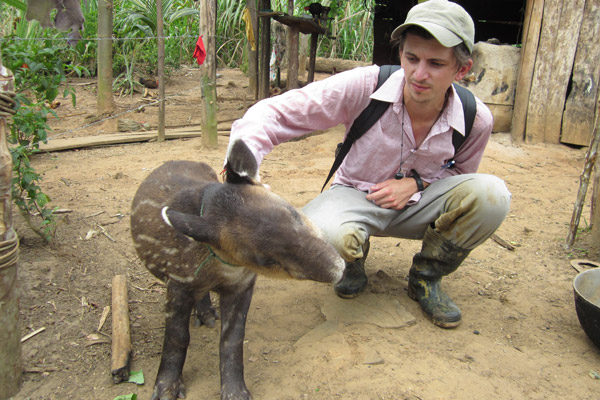
Chris Jordan helps to confiscate a baby tapir in Nicaragua. Jordan has recently started an indiegogo campaign to help raise funds for a tapir rehabilitation center on the Caribbean Coast for animals likes this one. Photo courtesy of Chris Jordan.
While tapir have been hunted for millennia by indigenous groups, the influx of settlers from the west has upset the balance between hunters and tapirs.
“[Indigenous groups] never cleared large expanses of forests for development, so the tapir population as a whole was able to withstand the hunting pressure, presumably through source and sink dynamics. However, since the middle of the 20th century, Pacific Coast colonists have been invading these communally owned forests to clear them for cattle pasture…Furthermore, the Pacific coast people hunt tapirs at very high rates,” explains Jordan.
The situation has put the entire tapir population in jeopardy in Nicaragua, leading the government to ban all tapir hunting. However, such laws are rarely enforced. Currently Jordan is working with the government and local authorities in better-enforce the tapir hunting ban, as well as leading education efforts with locals.
“If recent trends in tapir hunting continue, in another decade I doubt that the species will exist in the majority of its current range,” he says.
But even stopping hunting will not be enough, if Nicaragua’s forests are chopped down.
“There is an agricultural frontier sweeping across the country from the Pacific to the Caribbean Coast and rapidly destroying the forests that remain in Nicaragua,” Jordan explains. “In the Bosawás Biosphere Reserve, supposedly one of the better protected reserves in the country, we lose almost 43,000 hectares of forest every year. Total forest loss is well over 100,000 hectares annually and the rate has been growing in recent years.”
Deforestation is largely caused by illegal settlers moving into forest and cutting it down for cattle pasture, the illegal timber trade, land trafficking, or agriculture such as oil palm. According to Jordan, the best way to combat this is for the government to give indigenous people rights over their historic lands, and then back these rights with their full support.
“The situation is quite urgent and if the Caribbean Coast indigenous and afro-descendant populations aren’t empowered and supported adequately for them to control the destruction, and assisted in the process of making conservation of their forests a viable livelihood strategy, it is possible that there will be little forest left in Nicaragua in a decade or two,” Jordan warns.
In 2011, the Nicaraguan government established its first Ecological Battalions. These military units were charged with clamping down on the illegal logging epidemic in the country. However, Jordan says this has yet to work in many parts of the country, as the battalions have hampered by lack-of-resources and corruption. Still, Jordan, says the Ecological Battalions themselves are passionate about their task.
“I have been consistently impressed with how dedicated the soldiers are and have personally worked with several First Lieutenants who have shown real initiative in their efforts to protected Nicaragua’s forests,” he notes. “Furthermore, in the past year, the central government’s language and attitude toward illegal colonists and land traffickers in Caribbean coast Nicaragua changed drastically. Jaime Incer Barquero, an environmental advisor to President Ortega publicly called these colonists “cancerous cells” and the Sandinista government has made a public commitment to combat deforestation and forest fires more fervently during next year’s dry season.”
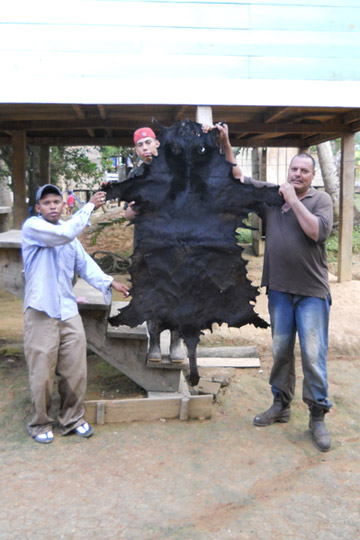 The skin of a black jaguar that had been put up for sale. Photo by: Christopher Jordan. |
This shift may not just be in the government as well, as Jordan says he’s seeing signs that civil society—especially in the youth—is taking the conservation of their resources more seriously. However, time will tell whether the new rhetoric will lead to progress on the ground, according to Jordan.
Much of the current battle over Nicaragua’s forest is coming to a head in Bosawás Biosphere Reserve, which has been overrun by illegal settlers.
“We are bearing witness to the complete destruction of one of the most important, largest reserves in Central America. I traveled to the reserve in April of this year to a region where I had done some camera trap sampling for tapirs in 2012 and there were no longer any forests,” Jordan explains. “Furthermore, the colonists that were in the area were simply destroying everything. A lot of them are not even looking to settle in the reserve, but are illegal land traffickers controlled by the “timber mafias” and thus have no interest in resource conservation. During my trip, these colonists were burning everything, including riparian forests and cattle roads their neighbors use daily, in order to clear more land faster.”
The destruction of the reserve has not just impacted the forests and wildlife, but also the indigenous people—the Mayangna and Miskito—who call it home and depend on its resources. These tribes have increasingly called on the government to take action to little avail, until they threatened to go to war with the settlers.
“Immediately after the threat of war emerged, the central government increased the Ecological Battalion’s presence and created an interdisciplinary committee to solve the Bosawás problem. The government began confiscating lumber, arresting illegal loggers, arresting illegal colonists, and removing corrupt officials who permitted the destruction of the biosphere. It began to look like the government was genuine about turning things around, but in the past few months their actions have begun to wane. Within the next year, we have been told that they will reveal a comprehensive plan for saving Bosawás,” explains Jordan. “In the meantime, it is critical that international conservationists and institutions pressure Nicaragua to conserve Bosawás. This past year’s skepticism from UNESCO helped to force the government’s hand to protect the reserve, so additional pressure could push them to increase their efforts further.”
In the end, the battle to keep Nicaragua’s tapir from vanishing is in fact a part of the much-larger conflict to safeguard the country’s rainforests and indigenous people. If the country’s forests are lost, the country will lose the rich natural resources that hold the potential for real sustainable development. If it’s indigenous people are overwhelmed, it could throw the war-weary country back into bloodshed and chaos. If Nicaragua’s tapirs are allowed to thrive, so might its people.
To help Jordan’s work in Nicaragua visit his indiegogo campaign, also follow his work on facebook and youtube.
AN INTERVIEW WITH CHRISTOPHER JORDAN
Jaguar in Nicaragua caught on camera trap.
Mongabay: What’s your background?
Christopher Jordan: I have a B.S. in Wildlife Conservation and a B.A. in Spanish and Latin American Studies from the University of Massachusetts Amherst, and am now finishing my Ph.D. in the Department of Fisheries and Wildlife at Michigan State University. I’ve been involved with wildlife research and conservation for around 8-9 years. I was born in Massachusetts, where I got most of my early experience, including jobs working with freshwater turtles, tiger beetles, and spotted salamanders. Around 7 years ago I transitioned to internships and field positions in Mexico and Central America, primarily working with terrestrial mammals. In 2009 I began my PhD research on a National Science Foundation Coupled Natural and Human Systems project looking at the impacts of road development on biodiversity and rural livelihoods in Caribbean Coast Nicaragua.
Mongabay: What drew you to tapirs?
Christopher Jordan: It’s hard not to be drawn to tapirs. They are remarkable animals both evolutionarily and ecologically. I was initially drawn to Baird’s tapirs in Nicaragua in the process of coordinating a camera-trapping survey of biodiversity along the country’s Caribbean Coast. There was very little published scientific data on tapirs in the country, but I was gathering a lot of information on them. So I decided to begin research focusing specifically on tapirs to generate a more comprehensive tapir database. Shortly after this, I was funded through the Mohammed bin Zayyed Species Conservation Fund to update our knowledge of the species’ national distribution.
I was also drawn to tapirs because of the people working with them. After one of my field seasons in Nicaragua, I presented my preliminary findings at the International Symposium organized by the IUCN/SSC Tapir Specialist Group (TSG) and later became the TSG’s Country Coordinator for Nicaragua. The TSG is by far the most enjoyable group of academics and conservationists I have worked with in my career. The entire group is not only willing, but excited to collaborate with one another and share data, ideas, and their expertise to help conserve tapirs worldwide. I really can’t say enough good things about the TSG; they have inspired me to intensify my focus on tapirs and to dedicate myself to their conservation not just in Nicaragua, but globally.
BAIRD’S TAPIR IN NICARAGUA
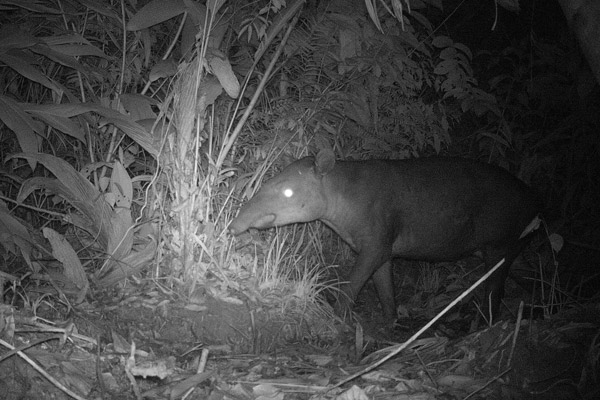
Baird’s tapir Nicaragua. Photo by: Christopher Jordan.
Mongabay: When most people think of Nicaragua they probably don’t think of tapirs. Will you tell us about this particular species and how it differs from other tapirs?
Christopher Jordan: We still officially consider there to be four species of tapirs worldwide. Three of these species are found in the Americas. The species that occurs in Nicaragua is the Baird’s tapir. Baird’s tapirs are classified as Endangered by the IUCN and the global population is estimated to be around 5,000-5,500.
Baird’s tapirs are the second largest species of tapir, with adult weights of somewhere around 400-600 pounds. This makes them the largest terrestrial mammal in Nicaragua. The two South American species are more closely related to one another than they are to Baird’s tapirs. They also have more genetic diversity than Baird’s tapirs.
All tapirs share some important similarities. For instance, they all play very important ecological roles, especially through seed dispersal and selective browsing, which helps to shape the structure of forests and determine forest regeneration pathways. They are also really unique animals with regards to their evolution and their anatomy. They have a proboscis that they use to grab foliage and as a snorkel when swimming. Tapirs have evolved relatively little throughout their history, so we can use their distribution through time as an indicator of historical forest cover. All tapir species also reproduce very slowly. Baird’s tapirs have a gestation period of around 400 days after which they give birth to a single young. The young stays with the mother for 12-18 months and doesn’t reach sexual maturity for several years. This sluggish reproduction cycle makes them very susceptible to hunting and habitat loss, two of tapirs’ largest threats globally.
Despite being very charismatic, interesting, large, and ecologically important species, there is a lot that we still don’t know about Baird’s tapirs and tapirs in general are poorly known amongst the public in their range countries.
Mongabay: How many tapirs do you estimate might still survive in Nicaragua?
Compliation of tapir videos in Nicaragua.
Christopher Jordan: My research team is just now gathering the data on tapir densities in different habitats in Nicaragua that we will need to estimate the population size in Nicaragua with any degree of certainty. However in prior years I surveyed most of the country for tapirs. Based on what we know about where they occur and density estimates in other countries, if I were forced to make an estimate, I would say there are somewhere between 900-1100 tapirs left in Nicaragua.
Mongabay: What have you learned about their range and behavior since studying them?
Christopher Jordan: Almost all of the data my team has collected is new for the country. Perhaps the most significant finding is that the Caribbean coast, which was previously considered a zone of extirpation by the IUCN, is actually the most important area of the country for tapirs. There is a lot of suitable habitat remaining; so much, in fact, that we think that the entire coast served as a genetic corridor between Honduras and Costa Rica until very recently. Palm oil plantation and road development over the past 5-7 years have almost certainly divided this Caribbean coast corridor, but with a moderate and very feasible amount conservation planning and reforestation, this corridor could very well be re-established.
Mongabay: What are the major threats to tapir here?
Christopher Jordan: There are three primary threats to tapirs: habitat destruction, hunting, and the capture and traffic of juveniles for the illegal pet trade.
All three of these have intensified in recent years due to the illegal expansion of an agricultural frontier driven by Pacific coast farmers and cattle ranchers. The farmers and ranchers leave their homes due to economic strife or after having destroyed their previous farms with unsustainable practices, and clear and settle in the protected areas along the Caribbean Coast. Suffice to say that all threats are very much interconnected and rapidly extirpating tapirs from their current range.
Mongabay: Who are the primary hunters of tapir? Why is the current ban so easily flouted?
Christopher Jordan: As in many developing countries, rural peasants are the primary hunters of tapirs. However the entire story regarding tapir hunting is more nuanced. Historically, the Caribbean Coast of Nicaragua was economically and culturally isolated from the Pacific coast and at the end of the civil war, was officially decreed an autonomous region where indigenous and afro-descendent groups have communal titles to the forests. Now throughout history these groups hunted tapirs, but they never cleared large expanses of forests for development, so the tapir population as a whole was able to withstand the hunting pressure, presumably through source and sink dynamics. However, since the middle of the 20th century, Pacific Coast colonists have been invading these communally owned forests to clear them for cattle pasture. Over the past decade or so, this wave of colonists has reached a critical mass and the autonomous regions now harbor more Pacific coast people than indigenous and afro-descendant people. Furthermore, the Pacific coast people hunt tapirs at very high rates. So what we’re seeing is that the traditional inhabitants are continuing to hunt at their historical levels on the Caribbean coast. However these rates are no longer sustainable because the large expanses of forests that once served as source populations for the hunted populations tapirs no longer exist, and because since around 2000, the hunting by the traditional inhabitants has been compounded by the extremely high rate of tapir hunting by colonists.
The main reason that hunting bans are so easily flouted is that environmental law enforcement has essentially no presence in the majority of forests in the Caribbean Coast. I have never come across a member of the national level natural resource ministry (MARENA) in a Caribbean Coast protected area. An Ecological Battalion was created as a part of the National Army in 2011 to help enforce environmental laws in rural contexts, however their posts are scattered about the country in strategic locations, so they have no real presence in the majority of forests. On top of this, they are primarily trained to stop illegal logging and do not actively enforce hunting laws. We are working in collaboration with the Nicaraguan National Zoo and MARENA to change this and push the army to better enforce hunting laws. But as things currently stand, in most cases, the indigenous and Afro-descendent communal landowners are left alone to monitor their lands and enforce their environmental laws. Even in contexts where these Nicaraguans have a strong drive to conserve their forests and defend their lands, they almost never have the adequate resources and manpower to effectively do so.
We are very concerned that this context will result in so much overhunting of tapirs that they will become extirpated from much of their range.
Mongabay: What needs to be done to make sure tapirs don’t disappear from Nicaragua?
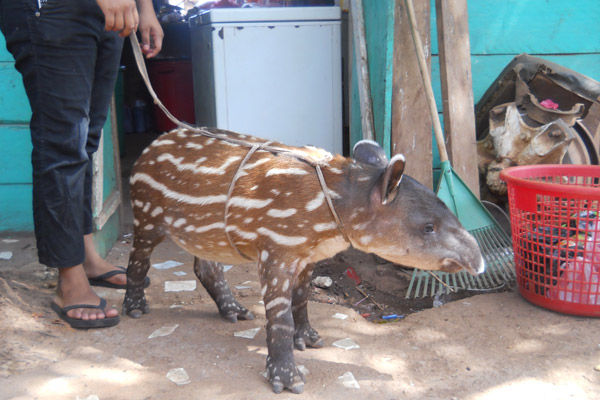
Captive baby tapir confiscated by authorities. Photo by: Christopher Jordan.
Christopher Jordan: There are two factors that will be critical to the survival of tapirs: a reduction in tapir hunting nationwide, and an honest effort by the government to help defend the country’s indigenous and afro-descendant forests.
There is a permanent ban on tapir hunting, but environmental laws are rarely enforced outside of major cities (where tapirs do not occur). We are working with territorial and local governments to create tapir hunting bans at these lower levels of government where laws are more likely to be meaningful to locals and enforced by the local autonomous authorities. To their credit, a lot of indigenous groups are very interested in this because the wildlife in their forests are important components of their cultures and their livelihoods. Most recently, the Awaltara Territorial Government drafted and approved a hunting ban for all endangered species. Over the next few months with the assistance of the IUCN Tapir Specialist Group, we have plans to hold workshops with them to help create a plan for monitoring and enforcing the ban. We are hoping to replicate this process with other territorial governments in the Caribbean coast throughout the next year.
The Pacific coast colonists do not tend to attribute as much cultural value to tapirs and thus are less open to the idea of exerting any kind of effort to conserve them. It is in these cases where we are working with the national army’s Ecological Battalion to help them to better recognize and prevent illegal hunting. In addition, through our environmental education efforts, we are trying to get as many Nicaraguans as possible, both Pacific coast Mestizo populations and indigenous and afro-descendant populations, to be not just aware, but proud that they have a globally important population of this species in their country. We think we are on the right track, but if recent trends in tapir hunting continue, in another decade I doubt that the species will exist in the majority of its current range.
The second issue, of securing indigenous communal land tenure and helping in the defense of Caribbean coast forests, is perhaps even more critical and will have an impact on both hunting and habitat loss. Historically the national government has not given the Caribbean Coast peoples the support they merit. As a case in point, the process to officially demarcate and title lands has been strategically drawn out for decades partially to avoid legal conflicts over land illegally settled by Pacific coast colonists. At other moments in history, actively encouraging illegal settlement of Caribbean Coast forests has been a key political strategy of the central government; by helping Pacific coast Mestizo peasants travel to and settle the Caribbean coast, the central government was able to increase its support in areas that at least traditionally were in opposition to them.
In recent years things have spiraled out of control and illegal loggers, cattle ranchers, and land traffickers are quickly destroying remaining forests and hunting unsustainably as they do it. The situation is quite urgent and if the Caribbean Coast indigenous and afro-descendant populations aren’t empowered and supported adequately for them to control the destruction, and assisted in the process of making conservation of their forests a viable livelihood strategy, it is possible that there will be little forest left in Nicaragua in a decade or two.
Mongabay: Beyond tapirs what are some other species found in the country that might surprise people?
A very rare video: camera trap catches a giant anteater in Nicaragua.
Christopher Jordan: Like all Central American countries, Nicaragua has extremely high biodiversity due to the diversity of its ecosystems. Perhaps the most famous of Nicaragua’s surprising species are the bull sharks in Lake Cocilbolca, which have been shown to journey from the open ocean, up the San Juan River, and into this huge freshwater lake. Despite this being a unique, fascinating part of Nicaragua’s natural history, unsustainable fishing practices, pollution, and persecution by humans has driven the bull sharks to the brink of extirpation from the lake. Lake Cocilbolca also has a variety of endemic cichlid species and is an important water resource for all of Central America. It will be really interesting to see the results of the feasibility and impact studies for the potential Interoceanic Canal, as most of the proposed routes cross this lake.
Other surprising species include the Jabiru stork, which many people may not associate with Nicaragua as well as the giant anteater. I believe the latter is extremely rare in the country as I’ve only been able to gather a handful of data on them.
One surprising use of wildlife is the massive green turtle fishery on the Caribbean coast. This historical fishery has existed for hundreds of years and feeds an exclusively national market. Locals consume over 10,000 adult green turtles every year. However it is an interesting topic to learn about in the context of so many sea turtle ecotourism efforts in surrounding Central American countries.
Mongabay: What role has camera traps played in your research?
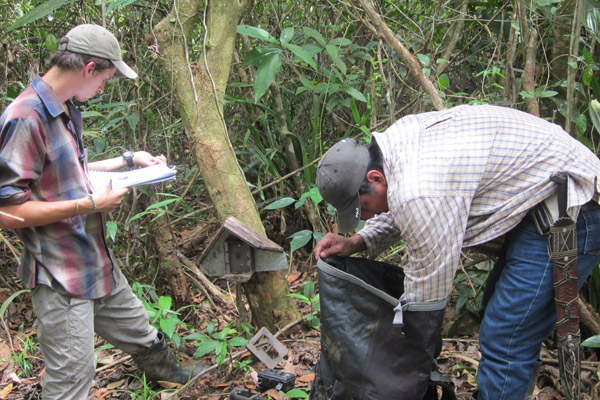
Jordan (left) and field assistant set camera trap. Photo by: Christopher Jordan.
Christopher Jordan: Camera traps have been a central part of my research in Nicaragua over the past five years. My study area is essentially the entire Caribbean Coast of Nicaragua and although I now focus on tapirs, I started researching terrestrial mammal diversity. This means that I work in a relatively large extension of land and in a variety of habitats that vary in anthropogenic impact with a diversity of target species. In some areas the forest is severely hurricane damaged and difficult to access, in others it is surrounded by agricultural lands and its fauna severely depleted by overhunting. This combination of factors, a very extensive study area, sites with low densities of wildlife and or poor visibility, and a variety of target species with different ecologies limit the ease with which I could use other methodologies, such as transect sampling. Camera traps have been perfect for collecting data on a diversity of species across this large, varied area.
In addition to this, due to both land conflicts with outsiders and a history of economic oppression by resource extractive companies, many of the indigenous and Afro-descendent communities, especially those in the north, are not immediately trusting of outsiders. While I have also spent considerable time living in communities and interviewing forest users and hunters to establish rapport, I don’t think I can understate the value of camera traps and the resulting photos and videos as gatekeepers and icebreakers. Camera trap results are engaging across cultures; everyone can enjoy the thrill of reviewing a camera’s photos for the first time. I have always made a point of printing photos and leaving albums in communities as well as reviewing camera trap images and photos with my field assistants, their families, and occasionally community leaders as soon as we bring a camera in from the field. Interacting through the photos and being able to offer tangible results to leave in the communities is a great way to connect to rural people.
I believe my research should benefit the location where it is carried out. While being able to give camera trap photos to communities doesn’t automatically ensure this, it has certainly opened doors and helped community leaders feel comfortable with collaborating with me. Iteratively reviewing results with them has allowed us to develop a trusting, working relationship to the point where territorial and local governments are comfortable coming to me to ask for assistance on projects or for reports to use in meetings. I can’t give camera traps all of the credit for this, but they certainly facilitated things and provided a powerful communication tool.
FORESTS AND INDIGENOUS GROUPS IN NICARAGUA
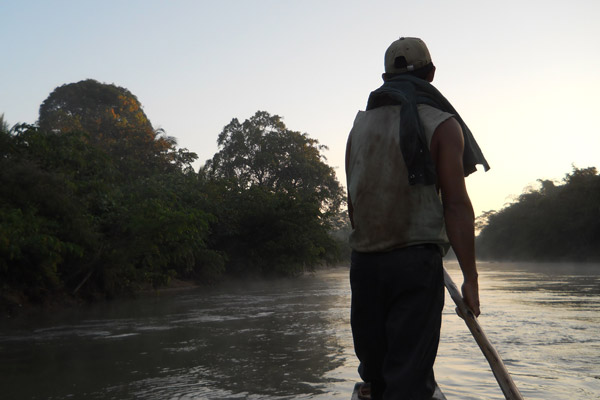
Mayangna canoeing through the Bosawás Biosphere Reserve. Photo by: Christopher Jordan.
Mongabay: Nicaragua still has a lot of forest, but it is under heavy threat. What are the primary drivers of deforestation here?
Christopher Jordan: There is an agricultural frontier sweeping across the country from the Pacific to the Caribbean Coast and rapidly destroying the forests that remain in Nicaragua. In the Bosawás Biosphere Reserve, supposedly one of the better protected reserves in the country, we lose almost 43,000 hectares of forest every year. Total forest loss is well over 100,000 hectares annually and the rate has been growing in recent years. This past dry season, the government estimated that the number of fires used to clear newly deforested areas for agriculture was three times greater than in 2012.
The primary causes of the deforestation are the illegal lumber industry, land trafficking, and the expansion of cattle ranching along the agricultural frontier. The illegal harvest and sale of lumber, primarily driven by foreign markets, has been a huge problem in the Caribbean Coast throughout history. Recently the illegal and legal harvest of rosewood threatened much of the coast. Currently there are huge problems with illegal timber harvest throughout the northern Caribbean Coast and in the Bosawás Reserve particularly. Recent reports suggest that the illegal timber extraction is driven largely by Chinese buyers and governed by “timber mafias” that gain access through corrupt government officials and use threats and violence to remain operational. The army has been very active in trying to reduce illegal timber extraction, and they have had surprising success, especially with rosewood, but more needs to be done.
Many rural peasants entering protected areas from the Pacific coast dedicate themselves to land trafficking as well. Land traffickers invade poorly monitored protected areas (typically indigenous lands), clear the land entirely, sell any marketable lumber, and then sell the cleared land generally using forged land titles or land titles granted illegally through corrupt local officials. Then the land trafficker moves onto other forested areas and repeat the process. The land traffickers have a surprisingly strong presence in the country’s protected areas, including some Pacific Coast reserves such as the Cosinguina Peninsula. A recent news article detailed the negative effects of these land traffickers on the tourist industry and wildlife in Cosinguina.
Finally the cattle ranchers purchase lands from these land traffickers and using the logging roads and infrastructure created by the timber companies, they bring in cattle and slowly expand their ranches on neotropical soils that are not suitable for expansive cattle ranching. The cattle ranchers are generally of two types: the wealthy rancher who can buy large extensions of land, and the poor rancher who buys small patches of land, often 2-3 hectares. The combination of these types of ranchers is completely destroying forests. Indeed, the wealthy ranchers buy large plots of land, but there generally remain small patches of forests between the farms that serve as wildlife corridors. However when the poor ranchers enter the picture and purchase the small remaining patches of forest to convert into small cattle pastures, they effectively destroy almost all wildlife habitat.
The individuals involved almost always know that their actions are illegal in one way or another. This makes them feel very threatened when confronted by outsiders, which means they become defensive and even resort to violence in some cases. There have been cases in the past year of illegal colonists and forest users killing national government employees and prominent members of indigenous governments for challenging their illegal activities.
One final, increasingly important factor in deforestation is oil palm. The rate of oil palm plantation growth has been startling in certain regions of Nicaragua and is beginning to threaten the Indio-Maíz Biosphere Reserve in the south.
Mongabay: Will you tell us about the Caribbean forests? What make these areas special?
Christopher Jordan: The Caribbean Coast has large extensions of lowland tropical rainforest, but also has seasonally flooded forests, mangrove forests, Raphia palm swamps, and extensive Caribbean pine savannahs.
Throughout history, the Caribbean Coast of Nicaragua has been conserved to a much greater degree than the Pacific Coast. This occurred for a variety of reasons. The climate throughout much of Central America is better for large scale agriculture and year round harvests on the Pacific side, thus this is where the population concentrated and agriculture developed on a large scale. Additionally, the Caribbean Coast was historically protected from Spanish invasion by British colonists and the Miskito. Further invasion was also prevented by the dangers of the Civil War through the 1980s. Aside from this, the traditional inhabitants, the Miskito, Mayangna, and Rama indigenous peoples, and the Garifuna and Kriol Afro-descendent peoples are small-scale horticulturalists who rotate crops and leave large forested areas as a component of their livelihood systems. Although it is debatable how environmentally friendly these groups really were, compared to Pacific coast farmers they are extremely green.
Due to this historical context, up until recently there existed a corridor of potential wildlife habitat along the Caribbean Coast from the Honduran border to the Costa Rican border. Corridors that run through entire countries are not common, especially when the corridors are not mountain ranges. We think that the Caribbean coast was until recently an important genetic corridor for many species, including tapirs. In the past five years or so, oil palm developments and the agricultural frontier have almost certainly disrupted gene flow in this corridor. However, we’re still at a point where conservation planning and reforestation efforts could re-establish the corridor function of the Caribbean Coast.
It’s frustrating that this sort of landscape level conservation planning isn’t currently a priority for those tasked with national level conservation planning. Instead, they are scrambling to address the critical threats to the country’s most important biosphere reserves.
Mongabay: These areas are currently governed by indigenous people and afro-descendant people, how does that impact conservation efforts there?

Rainforest destruction on the Caribbean Coast. Photo by: Christopher Jordan.
Christopher Jordan: From a logistical perspective, the fact that the Caribbean coast ecosystems are autonomous regions governed by different indigenous and afro-descendant groups makes it somewhat more complex to carry out research and conservation efforts. This is because a researcher or conservationist has to acquire permits from a whole host of governments and government agencies.
Perhaps more importantly, when researchers and conservationists work in forests where local peoples have a resource extractive based subsistence lifestyle, it is unethical to exclude them from the work. In contexts where these forest residents are traditional habitants who have been repeatedly overlooked, marginalized, and taken advantage of, this makes the researcher’s responsibility to involve local people in research even greater.
Mongabay: You’ve worked closely and collaboratively with indigenous people. What advice would you give scientists in how to best establish partnerships with indigenous groups?
Christopher Jordan: If ecologists want to legitimately include and collaborate with local and indigenous peoples, I think it is necessary to pair ecological research efforts with social science. In my case, I spent almost a year dedicating my spare time to mental model and oral history interviews exploring local peoples’ relationships with non-human animals and their forest use in general. This allowed me to get a much better idea for how the locals viewed my research, how I could re-shape our collaboration to increase local benefits, and how to establish fair working relationships with the local environmental experts that are directly involved in the research process.
It is also important to not simply be honest, but completely transparent, even when it doesn’t seem necessary. This includes explaining the benefits that all involved parties will receive through the conservation and explaining data, results, and conclusions. To effectively do this, researchers must spend a lot of time trying to understand local cultures and ways of viewing their ecosystems through reading any available literature and living with and interacting with locals.
In many cases, indigenous and traditional peoples have suffered through unfair business deals drafted by resource extraction companies. In other cases, they have had to fight wars to keep hold of their territories and ways of life. In most cases they have been marginalized and unjustly treated. If researchers are not totally transparent from the beginning to the end of a research project, it can create friction between locals and researchers and also the locals and future conservationists.
Mongabay: How is the central government working to prevent deforestation? Is this working? Why or why not?
Christopher Jordan: The first and most direct method the government uses to prevent deforestation is through their Ecological Battalions. The central government created a branch of the national army called the Ecological Battalion a few years ago and established army posts in protected areas and other strategic locations to enforce environmental laws. The soldiers patrol sensitive areas, create checkpoints along routes that colonists take into forests, and monitor logging trucks and equipment to ensure that loggers have the proper permits.
MARENA also holds forums and workshops in and around the capital city of Managua to encourage the adoption of environmentalist philosophies and a greener lifestyle. The central government has been pushing reforestation over the past year.
To be honest, these efforts are not yet working to curb deforestation. Part of this is a result of the priorities and resources of the central government. Nicaragua is a very poor country, and like other poor countries globally, they feel that they don’t have the luxury to invest heavily in forest and natural resource protection. So despite having a few plans to curb deforestation, MARENA just doesn’t have the personnel or the budget to have a very strong presence in the country’s isolated areas where most forest remains. Their efforts are primarily focused on the Pacific coast. This has resulted in some reforestation in Central Nicaragua, but efforts to protect Caribbean Coast forests have been mostly superficial to date.
However the cause of the inefficacy is not entirely a lack of adequate budget. There is a lot of corruption in the regional MARENA delegations, where delegates are generally appointed for political or financial reasons rather than their qualifications. I have heard many reports of instances where companies have greater influence over environmental decisions than the ministry of natural resources. For instance, there have been cases where regional delegates are pressured to legitimize illegal logging by issuing permits to timber companies after the timber is harvested, and on occasion even after the timber is seized by the army. There have also been scenarios where delegates have refused to cooperate with or issue permits to environmental NGOs and environmentalists simply for publicly disagreeing with them or challenging their decisions. The central government’s lack of authority and presence in the Caribbean coast region means that these actions continue unabated. Neither the corrupt delegates nor those responsible for the most deforestation view the central ministry of natural resources as legitimate.
Yet I have a lot of hope that this is changing. First, despite some initial problems with the Ecological Battalions, I have been consistently impressed with how dedicated the soldiers are and have personally worked with several First Lieutenants who have shown real initiative in their efforts to protected Nicaragua’s forests. I have also been impressed with the regional and national commanding officers of the Ecological Battalions and am convinced that they believe in their missions and will continue to develop the Battalions until they are effective.
Furthermore, in the past year, the central government’s language and attitude toward illegal colonists and land traffickers in Caribbean coast Nicaragua changed drastically. Jaime Incer Barquero, the personal environmental advisor to President Ortega publicly called these colonists “cancerous cells” and the Sandinista government has made a public commitment to combat deforestation and forest fires more fervently during next year’s dry season. They also very publicly ordered additional troops to prevent colonization of the Bosawás Biosphere Reserve in response to uncertainty on behalf of UNESCO on whether or not the reserve could continue to be classified as a Biosphere.
In addition to this, there really are a lot of very passionate people within MARENA, including the Minister. She has been very receptive of our project and has gone out of her way to show us support. On a few occasions she has directly allocated resources to help us out. Most recently she lent us a truck, gasoline, and a field technician for an attempt to confiscate an illegally held tapir that was for sale near Rosita.
There is also a very visible change in the attitudes of Nicaraguan youth, primarily in urban areas and near the country’s two Biosphere Reserves. This is almost certainly due to the efforts of the central government, including First Lady Rosario Marillo, to promote a greener lifestyle in Managua. There are also many environmental NGOs doing good work near the biospheres that contributes to this attitude change.
In short, the central government’s efforts are not yet effective and with the current level of corruption and inadequate resources, it will be a struggle to control deforestation in the near future. Nonetheless, we are beginning to see signs of a sea change in the country. Over the next year, especially after the government’s plan to save Bosawás is unveiled, we will see how sincere these changes are.
Mongabay: Recently, news has come out that the Bosawás Biosphere Reserve and its indigenous people are under assault by thousands of illegal settlers. Would you tell us more about this situation?
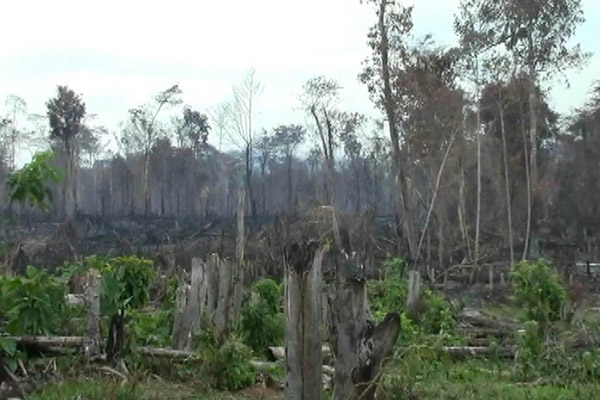
Burned forest in Bosawás buffer zone. Photo by: Christopher Jordan.
Christopher Jordan: The situation in Bosawás is extremely disheartening. We are bearing witness to the complete destruction of one of the most important, largest reserves in Central America. I traveled to the reserve in April of this year to a region where I had done some camera trap sampling for tapirs in 2012 and there were no longer any forests. Furthermore, the colonists that were in the area were simply destroying everything. A lot of them are not even looking to settle in the reserve, but are illegal land traffickers controlled by the “timber mafias” and thus have no interest in resource conservation. During my trip, these colonists were burning everything, including riparian forests and cattle roads their neighbors use daily, in order to clear more land faster.
The reserve loses between 40,000-50,000 hectares every year. It has been estimated that almost half of the reserve, including a very conservative estimate of 20-30% of the core area, has been damaged by colonists. The indigenous people who live in and have legal tenure over these forests are getting desperate. These are mostly indigenous Mayangna peoples. They have never had the financial resources to monitor the entirety of Bosawás, but their livelihoods depend on the reserve, even those areas they don’t frequently or ever visit. The reserve ensures their food security, supplies them with clean water, and provides their building and living materials. They recognize that the destruction of their reserve is a direct threat to their lives and many are extremely committed to it protection. A Mayangna group recently threatened to go to war against the colonists if the central government doesn’t intervene with a comprehensive, sincere strategy.
Immediately after the threat of war emerged, the central government increased the Ecological Battalion’s presence and created an interdisciplinary committee to solve the Bosawás problem. The government began confiscating lumber, arresting illegal loggers, arresting illegal colonists, and removing corrupt officials who permitted the destruction of the biosphere. It began to look like the government was genuine about turning things around, but in the past few months their actions have begun to wane. Within the next year, we have been told that they will reveal a comprehensive plan for saving Bosawás.
In the meantime, it is critical that international conservationists and institutions pressure Nicaragua to conserve Bosawás. This past year’s skepticism from UNESCO helped to force the government’s hand to protect the reserve, so additional pressure could push them to increase their efforts further.
One of the most encouraging developments concerning Bosawás is the manner in which the Nicaraguan youth has responded. Over the past year or so, several groups of students, including “Mision Bosawás” have been organizing information sessions, lectures, concerts, and cultural events in support of Bosawás. They have also organized excursions to Bosawás to learn about Mayanagna culture and to experience the nature of the threats to the biosphere first hand. It is too soon to know whether or not this will develop until a successful, long-term movement, but it is very encouraging and not something that I saw a lot of five years ago.
Mongabay: Will you tell us about the Ecological Battalion? How is this model working?
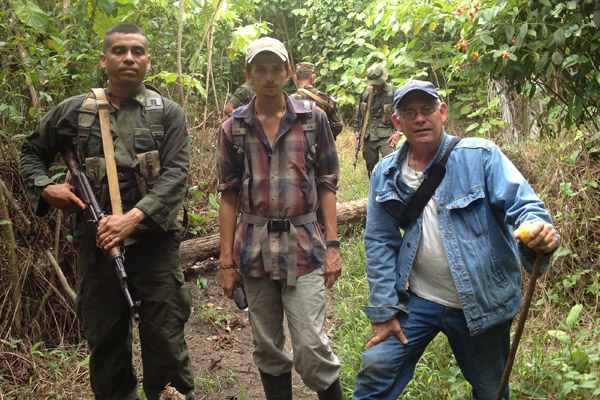
Jordan (middle) with eco-battalion member (left). Photo courtesy of: Christopher Jordan.
Christopher Jordan: I want to again commend the soldiers and commanding officers of the Ecological Battalions. They are making what I perceive as an honest effort and are very passionate about their work.
However, the model is not quite as effective as it needs to be. The soldiers are tasked with enforcing the environmental laws of the country, however, in most cases, they must carry out this work in the absence of the ministry of natural resources. This means that the soldiers must interpret environmental laws in the context of their field sites. Due to their uncertainty, they typically end up only acting in the most extreme, publicly egregious breaches of environmental law. In other words, they will intercept 8 clearly illegal logging trucks stacked with a banned timber species, yet they are less likely to act when an illegal colonist kills a tapir, despite the law permanently banning hunting this species.
In addition to this, soldiers are rotated from post to post approximately every 2-3 months. This creates a large problem because they have no formal way of leaving information for their replacements to pick up the work that the soldiers leave off. As a case in point, we collaborate most closely with the Ecological Battalion in the Wawashang Reserve. There was a particularly active group of soldiers at the Wawashang post this past March-April. We worked closely with them to start monitoring and punishing illegal hunting. We also introduced them to the farmers and community members who collaborate most closely with us and set up plans for them to monitor their farms for poachers. In short, we made a lot of progress with this group and began cracking down on tapir hunters. Nonetheless, in May, the entire troop was replaced, and no information was left behind, so we had to start from scratch.
Yet, their passion as a whole, including the passion of regional and national level leaders, gives me hope that they will continue to develop their model until it is effective.
CONSERVATION WORK IN NICARAGUA
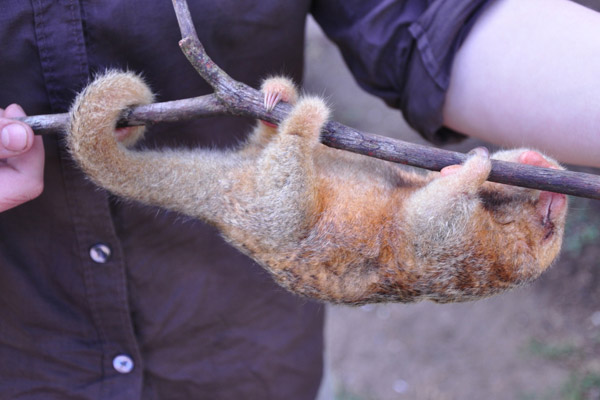
Silky anteater (Cyclopes didactylus) in Nicaragua. Photo by: Christopher Jordan.
Mongabay: Can you tell us what the conditions for people are like in Nicaragua as the second poorest country in the northern hemisphere (after Haiti)?
Christopher Jordan: In general there are not a lot of jobs in Nicaragua, and those that are available do not pay well. An elementary school teacher’s salary, for example, will maybe fall somewhere between $200-$300 a month. A professional veterinarian working for the government may earn $400 a month. While the cost of living is certainly lower than it is in New York City, things are not dirt-cheap, so an individual’s salary is almost never adequate.
In addition, the Caribbean Coast, especially the northern Caribbean Coast, is the poorest region of Nicaragua. Until recently, there were essentially no roads that connected this coast to Managua. Although this has been changing in recent years, the road network reaching smaller communities remains very limited throughout the entire coast, which means that for provisions to reach rural peasants, it can take days or sometimes weeks depending on weather conditions. The majority of indigenous and afro-descendant Caribbean coast Nicaraguans thus have a subsistence economy and rely on small-scale agriculture, artisanal fisheries, and hunting. In a lot of these communities, the adults are environmental experts who care deeply about their environment and love the autonomy that their lifestyle grants them.
The new roads are changing this and creating a market based economy in certain economic hubs. As a result certain fisheries have quickly become exhausted and forests depleted. Development over the past decade has brought cable television, cellphones, and Internet to large portions of the population. In fact the rate of change has been astonishing during my 5 years on the Caribbean Coast. A lot of the communities where I started working didn’t even have electricity when I began my research, but now have electricity, cellphone signals, cable television and Internet.
Many Caribbean Coast people still live in wooden houses with thatched palm roofs and work for themselves and their families: planting, hunting, and fishing. Yet at the same time they have better access to markets and an increasing need for money. As the agricultural frontier and market-based resource extraction penetrate the coast, the indigenous and Afro-descendant people increasingly struggle to live off their environment, struggles they never really had in the past. Given that there are very few jobs, a lot of Caribbean Coast people are desperate, which has led to the unsustainable exploitation of resources and increasing problems with alcoholism and drug addiction.
Despite their hardships, the Caribbean Coast culture always shines through. The Coast’s residents are at heart very humble, relaxed, and open people. Once they begin to trust you, they are very willing to share their homes, thoughts, and knowledge with you.
Mongabay: How does the past civil war still impact conservation work and the general populace today?
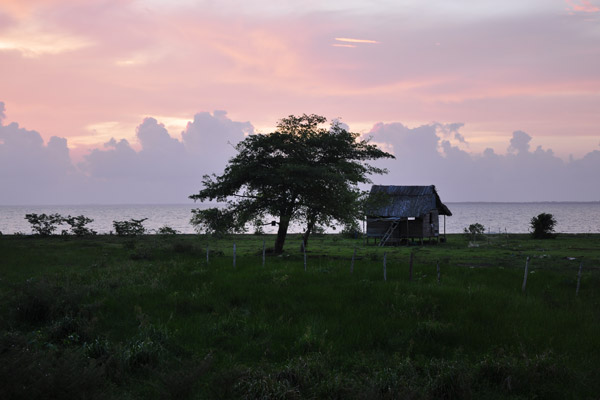
Miskito community in Kahkabila on the Caribbean Coast. Photo by: Christopher Jordan.
Christopher Jordan: The civil war introduces another fascinating aspect of working in Nicaragua. For the reasons I mentioned previously, there are really very few candidates from universities available to be field assistants, so it is often necessary, ethical, and most efficient to hire local environmental experts from each community to help with ecological research. A lot of these field assistants are ex-combatants who are experts in surviving in the Nicaraguan jungles. Thus every research trip to the forest is an incredible learning experience. In my years I’ve accumulated a lot of rainforest foraging and survival skills that I would have never been exposed to if I had done my work in a biological station with university students, and I am very grateful to my various collaborators for teaching me as much as they have.
One of the more interesting things I have learned about the civil war through my research was how it affected hunting along the Caribbean Coast. I collected historical data on tapir hunting from around the 1950s until the present day. The data show a significant decline in the use of firearms to kill tapirs during the civil war years and in the decade after the war. During the war, it was apparently too dangerous for one to fire weapons while hunting due to the risk of alerting the enemy to one’s position. After the war, the government decommissioned the majority of firearms. Tapirs are most easily hunted with firearms because of their size, so these things made tapir hunting more difficult. From the year 2000 until today, the use of firearms to kill tapirs has once again risen to pre-war levels.
Of course working with a population who grew up during a war has a lot of complications. When a person is accustomed to war, it seems like they have more trouble adopting a long-term vision and rather concentrate on ensuring their survival one day at a time. The high level of poverty in Caribbean Coast Nicaragua compounds this. A long-term vision is really a luxury that many cannot afford. This is of course antithetical to how we approach the world as conservationists and leads to the selling resources, overharvest, or other environmentally destructive behaviors that yield quick economic returns. In this context it is really important to identify local gatekeepers who have a longer-term, more conservationist point of view and to become allies with them. These allies have much more credibility and a much easier time when explaining the benefits of certain conservation behaviors or projects to their fellow community members than it is for an outsider who has not necessarily shared the same reality.
Mongabay: What role does the illicit drug trade play where you work? How does this complicate matters for conservation?
Christopher Jordan: The Caribbean Coast of Nicaragua is an active drug running route, meaning the illicit drug trade has a large impact on the majority of the communities along the Caribbean coast.
The effects are amplified by the extreme poverty in the region. Working for local drug kingpins is one of the few opportunities for a steady job. Most employees purchase barrels of gasoline and supplies and use personal boats to deliver these to drug traffickers in coastal waters. It can be a dangerous job and often leads to days or weeks in jail, but it is not uncommon work.
Locals also derive income from the drug trade in other ways. The Nicaraguan navy is very good at capturing drug traffickers. When the navy is in close pursuit of a trafficker, the drug runners often look for opportunities to dump their cargo into the sea. These floating packs of primarily cocaine wash up on rural beaches or find their way into fishing nets, providing a quick and comparatively huge payday for rural fishermen.
The implications of this are both good and damaging for communities. I remember reading a recent news item describing a northern Caribbean Coast communal government that declared all cocaine money was to be used as a development fund, partially to protest a lack of support from the central government. Sometimes those who find drugs make good investments and improve their lives. If the money is put to good use to improve the quality of life, it is hard to fault rural peoples for using it. Nonetheless, most of the money earned from selling abandoned cocaine is spent on alcohol and parties, and not to improve quality of life in the long term. In the most tragic and not uncommon scenario, I have seen communities become addicted to crack and when residents find cocaine, the party who locates the package makes crack and sells it their own family and friends.
Although it seems like an extraordinary event, cocaine actually washes up on shore quite frequently. Fishermen out at sea also make a point of searching for cocaine, which they sometimes call “white lobster” and some even make trips just to search for drugs when they hear news of a big bust. It occurs enough that a lot of the youth living along the coast now dedicate themselves to walking up and down the beach rather than farming. In some places, this has even decreased deforestation due to the decrease in farming. Of course, the decreased presence of indigenous and afro-descendant residents in the forest also decreases forest monitoring and opens the doors for the colonization of their lands by outsiders.
Locals also occasionally lament the central government’s success at catching drug traffickers. Recently one of the Bluefields kingpins, Ted Hayman, was captured and thrown into jail and the reaction along the coast was mixed. Hayman was an important employer in the region, and had the support of many people. Rumor has it that he periodically held huge parties during which he paid local shops large fees with the instructions that they were not to charge any customers for their food and supplies during the duration of the festivities.
The drug trade has affected my work most directly in my southernmost sites, to which I travel to by boat in the Caribbean Sea. A drug trafficking boat being chased by the navy arrived at the community where I was working on one occasion. This of course created chaos and disrupted my fieldwork, but highlighted another way in which locals earn money from drug traffickers. When drug runners arrive in a community in this context, the community members assist in hiding cocaine and helping the drug runners to flee from the authorities in exchange for fairly large fees. I have to be really careful in scenarios like this and refuse to give anyone a lift in our boat from community to community, to be sure that no cocaine enters the boat I am in. Locals also have to be careful in this scenario and resist the temptation to steal the hidden drugs. Just last year two locals who had helped me install cameras for years were murdered over stolen drugs.
One other way in which the drug trade affects conservation and research in the region is the skewed economic outlook it creates. Many locals have become accustomed to acquiring large sums of money rapidly and are less willing to work for reasonable wages on conservation and research projects. Similarly, communities are often more interested in projects that create instant wealth rather than the long term, often low yield investments embodied by research and conservation.
In short, the illicit drug trade has far reaching social, economic, and environmental implications.
Mongabay: Why is it so important to support young scientists and conservationists in Nicaragua?
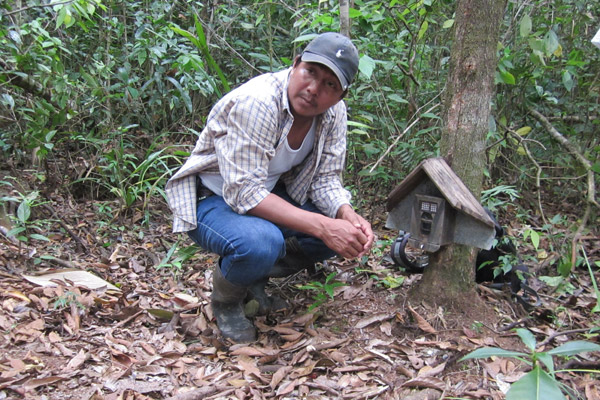
Field assistant setting camera trap. Photo by: Christopher Jordan.
Christopher Jordan: Wealthy Nicaraguans have never had bank accounts that depend on the economy of Nicaragua, but rather have been invested in the economies of developed nations. Thus, although there is some evidence that this is changing, Nicaraguan investors have looked at citizens of their own country as little more than a source of cheap labor. This obviously impedes comprehensive development. Furthermore, in many cases, jobs and important positions are awarded based on politics rather than qualifications or experience. So with national investors unwilling to fully support fellow Nicaraguans; and work experience, university grades, and other qualifications not necessarily resulting in a good job, there just isn’t enough incentive for many students to apply themselves and make sacrifices to get experience and get ahead of their peers, unless they see a clear trajectory leading to a job outside of the country. Due to this, it can be a challenge to find students or potential field assistants who are willing to dedicate themselves to research and conservation as an investment in their future and their country’s future. Such dedicated students and conservationists do exist though, and I think it is extremely important to give them every opportunity possible to learn and develop, and reward them for their long-term vision.
The state of science and science education in Nicaragua also remains in very rough shape. This is reflected by the general misunderstanding of what constitutes good research and why research integrity must be a priority for conservation. I have seen government officials and environmental NGOs make exaggerated claims based on inadequate data or simply lie about results that don’t suit a particular agenda. Of course Nicaragua isn’t the only country where this occurs, but it has a larger impact in Nicaragua, a country where most students have not acquired an adequate science background during their high school and university education. There are very few capable local scientists to challenge questionable scientific conclusions, thus the more publicly visible, politically-driven scientists are those shaping how the public views science. This can create obstacles for those of us who have been educated to have a moral obligation to conduct sound, honest science.
The poor state of science in the country is also reflected by the dearth of quality research carried out on the country’s flora and fauna. We simply don’t know a lot about Nicaragua’s biodiversity, including where different species occur, and how their populations are faring. There are some exceptions to this, including great green macaws in the Rio San Juan area, jaguars in Bosawás, fish stocks in Pearl Lagoon, Baird’s tapirs nationwide, and sea turtles on both the Caribbean and Pacific Coasts. Nonetheless, our knowledge about most species in the country is limited at best.
In this context, it is extremely important to create research projects in the country, and to create research job opportunities for Nicaraguans. Then it is important to find current and future university students who are passionate about conservation and involve them in the projects in ways that build their experience and prepare them to hold these jobs now and in the future. They deserve to get a good science education and to properly participate in the decision-making process related to natural resource conservation and exploitation. The country would benefit greatly from a strong foundation of Nicaraguan scientists working to understand and conserve the country’s flora and fauna.
Mongabay: Given all these challenges, what keeps you working in Nicaragua?
Christopher Jordan: Part of the reason I continue working in Nicaragua is practical. I have spent years building a network that both supports me and my work in Central America and benefits from having me positioned in this country. On top of that, at least in the short term I believe that I can contribute more here than I would be able to in a different context, say in the U.S.
However at a more fundamental level, the challenges make working here extremely interesting and rewarding. Nicaragua has an absolutely fascinating history, and the majority of challenges we’ve discussed are rooted in Nicaragua’s political, environmental, and economic history. Attempting to understand and navigate the challenges therefore gives me the opportunity to delve into the country’s history in a new way and to learn new things.
Mongabay: How can people help conservation efforts in the country?
Christopher Jordan: To some degree and in some areas of the country, it is important for more people to visit Nicaragua and to become invested in the wellbeing of the country and its flora and fauna. Tourism has increased markedly in the past year or two due to the international press’ interest in the country. Yet most people come to resorts, very small reserves, or to buy retirement homes on the beach and aren’t exposed to any of the complex issues resulting in the destruction of Nicaragua’s biodiversity. I imagine this is similar to tourism experiences in other developing countries, but it would do a lot of good for tourists to visit some of the more threatened areas to help draw attention to the primary drivers of environmental and cultural destruction. As I mentioned previously, the international outrage focused on the destruction of Bosawás helped force the government to act; similar campaigns focusing on other reserves may have a similar effect.
There are also several environmental NGOs that take volunteers or donations, including the Foundation for the Autonomy and Development of the Caribbean Coast of Nicaragua (FADCANIC) and the Friends of the Nicaraguan National Zoo (FAZOONIC). FAZOONIC runs both the country’s only rescue center and the national zoo. Some of the key members of our tapir conservation project are from the FAZOONIC and FADCANIC.
We are also in the midst of an indiegogo campaign to raise money for our Wawashang Tapir Rescue and Re-habilitation Center. Those who wish to contribute without leaving the country can visit the campaign’s website. We also frequently post videos and updates on our tapir conservation work on facebook and youtube, and by checking these pages frequently you can learn about ways to get involved.
I should stress that we would love for more people, institutions, and universities to get involved with our project. This doesn’t necessarily mean that we want donations, either. We would love for the general public, including artists, marketing students, researchers, and zoos to get in touch with us with ideas of their own for how they can contribute to ensuring Baird’s tapir survival in Nicaragua. We like to keep our doors open to all potential collaborators and all different approaches to conservation. So please contact me with your ideas, comments, and suggestions.
Mongabay: You’ve accomplished a lot in your career so far. What advice would you give students thinking about undertaking a career in conservation?
Tapirs caught on camera trap in Nicaragua.
Christopher Jordan: I would stress the importance of striving to keep one’s studies as interdisciplinary as possible. To successfully navigate the challenges of conservation, one needs to be a student of anthropology, marketing, communication, history, and on and on and on. In most university programs, this can be a more difficult task than it seems. Yet it is extremely important to be able to work closely with people and have the tools to learn about them and their cultures. I am not just referring to local people either, but also donors, the press, other researchers, other conservationists, and universities.
For university students working on research projects interested in applying their work in conservation initiatives, I also suggest taking a very long-term view of how their research can affect the study area. Students, especially Master’s and PhD students, often have the incentive to be really efficient and to get results as quickly as possible, but this does not necessarily produce the best results with regards to a long-term conservation effort. In the context of non-pristine, lived-in landscapes, it is necessary to go through an extended learning process to establish rapport with locals and to truly understand the complexity of the issues and questions surrounding research and conservation. It is also important to know government officials and employees and how their operations work. This can mean taking breaks from biodiversity research to spend time simply living with locals, attending meetings and presentations by resource agency employees, and getting to know all of the potential stakeholders. Taking shortcuts through this process will make it difficult to create a strong foundation of local and national support. This doesn’t mean it should be a priority to always make everyone happy, but rather that this type of learning process is necessary to craft a long-term plan for success.
It is also important to always act with humility and to keep your doors open to any and everyone. Conservation is complex work with a diversity of players. All of these players, regardless of how important, powerful, or outspoken they may seem, have the potential to positively or negatively affect a conservation project. So it is important as project coordinators to welcome and communicate effectively with everyone, and learn to work with them to see how they can best co-exist with, benefit from, or contribute to your work.
Related articles
Dry forests disappearing faster than rainforests in Latin America
(08/21/2012) Countries across Latin America lost 78,000 square kilometers of subtropical and tropical dry broadleaf forests between 2001 and 2010, according to a new satellite-based assessment published in the journal Biotropica.
Malaysia may be home to more Asian tapirs than previously thought (photos)
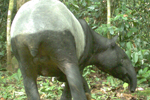
(04/23/2013) You can’t mistake an Asian tapir for anything else: for one thing, it’s the only tapir on the continent; for another, it’s distinct black-and-white blocky markings distinguishes it from any other tapir (or large mammal) on Earth. But still little is known about the Asian tapir (Tapirus indicus), including the number surviving. However, researchers in Malaysia are working to change that: a new study for the first time estimates population density for the neglected megafauna, while another predicts where populations may still be hiding in peninsular Malaysia, including selectively-logged areas.
Photos: Scientists discover tapir bonanza in the Amazon

(01/22/2013) Over 14,000 lowland tapirs (Tapirus terrestris), also known as Brazilian tapirs, roam an Amazonian landscape across Bolivia and Peru, according to new research by scientists with the Wildlife Conservation Society (WCS). Using remote camera trapping, thousands of distribution records, and interviews, the researchers estimated the abundance of lowland tapirs in the Greater Madidi-Tambopata Landscape Conservation Program made up of three national parks in Bolivia (Madidi, Pilón Lajas and Apolobamba) and two in Peru (Tambopata and Bahuaja Sonene).
Loving the tapir: pioneering conservation for South America’s biggest animal
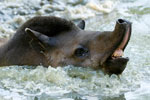
(09/11/2011) Compared to some of South America’s megafauna stand-out species—the jaguar, the anaconda, and the harpy eagle come to mind—the tapir doesn’t get a lot of love. This is a shame. For one thing, they’re the largest terrestrial animal on the South American continent: pound-for-pound they beat both the jaguar and the llama. For another they play a very significant role in their ecosystem: they disperse seeds, modify habitats, and are periodic prey to big predators. For another, modern tapirs are some of the last survivors of a megafauna family that roamed much of the northern hemisphere, including North America, and only declined during the Pleistocene extinction. Finally, for anyone fortunate enough to have witnessed the often-shy tapir in the wild, one knows there is something mystical and ancient about these admittedly strange-looking beasts.